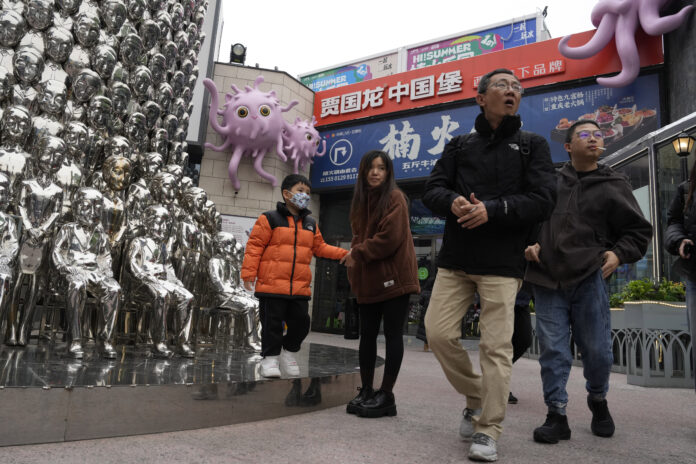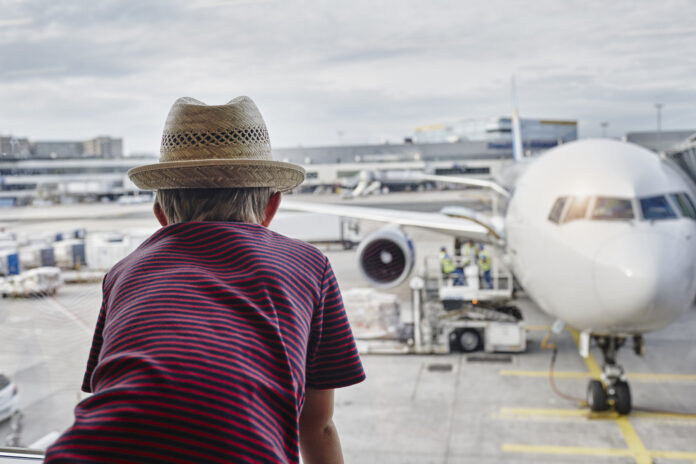Siemens Energy unveils massive loss
FRANKFURT (AFP) – Siemens Energy reported a EUR4.59-billion (USD5-billion) annual loss on Wednesday, dragged down by a crisis in its wind power unit, a day after a government-backed rescue package was unveiled for the German group.
The huge loss in the 2022-2023 financial year for the company, whose operations range from building wind turbines to power grids, was far larger than a loss of several hundred million euros the year before.
While large parts of its business, such as those related to gas and power grids, were healthy, the results were hit by the crisis in its Gamesa wind power subsidiary.
Gamesa has faced long-running technical problems with its onshore wind turbines, which have cost huge sums to fix.
“The wind business remains a major challenge and has led to the net loss in 2023,” said the company, admitting it had suffered a “serious setback” in the previous year. The group’s performance in the “near to mid-term” would continue to be impacted, and Gamesa is only expected to break even in financial year 2026. Siemens Energy runs its financial year from October to September, and the annual results were announced a day after a EUR15-billion, state-backed rescue deal was unveiled after weeks of talks.
The deal involves providing “guarantees” to Siemens Energy to allow it continue financing major long-term projects.
The Economy Ministry announced it would grant the company EUR7.5 billion worth of guarantees, and others involved included private banks as well as the larger Siemens conglomerate, which is a major shareholder in Siemens Energy.

Birds gone wild: New Zealand’s puking champ takes the crown

WELLINGTON (AFP) – A “weird puking bird” with a bizarre mating dance has won New Zealand’s annual avian beauty contest, triumphing after British comedian John Oliver launched an unlikely global campaign.
The unfancied Australasian crested grebe soared to an unexpected victory in the Bird of the Century ballot on Wednesday, backed by voters from far-flung cities including Tokyo, London and Paris.
Oliver used his popular television show to meddle in New Zealand’s beloved competition, urging viewers to back the species more commonly known by its Maori name “puteketeke”.
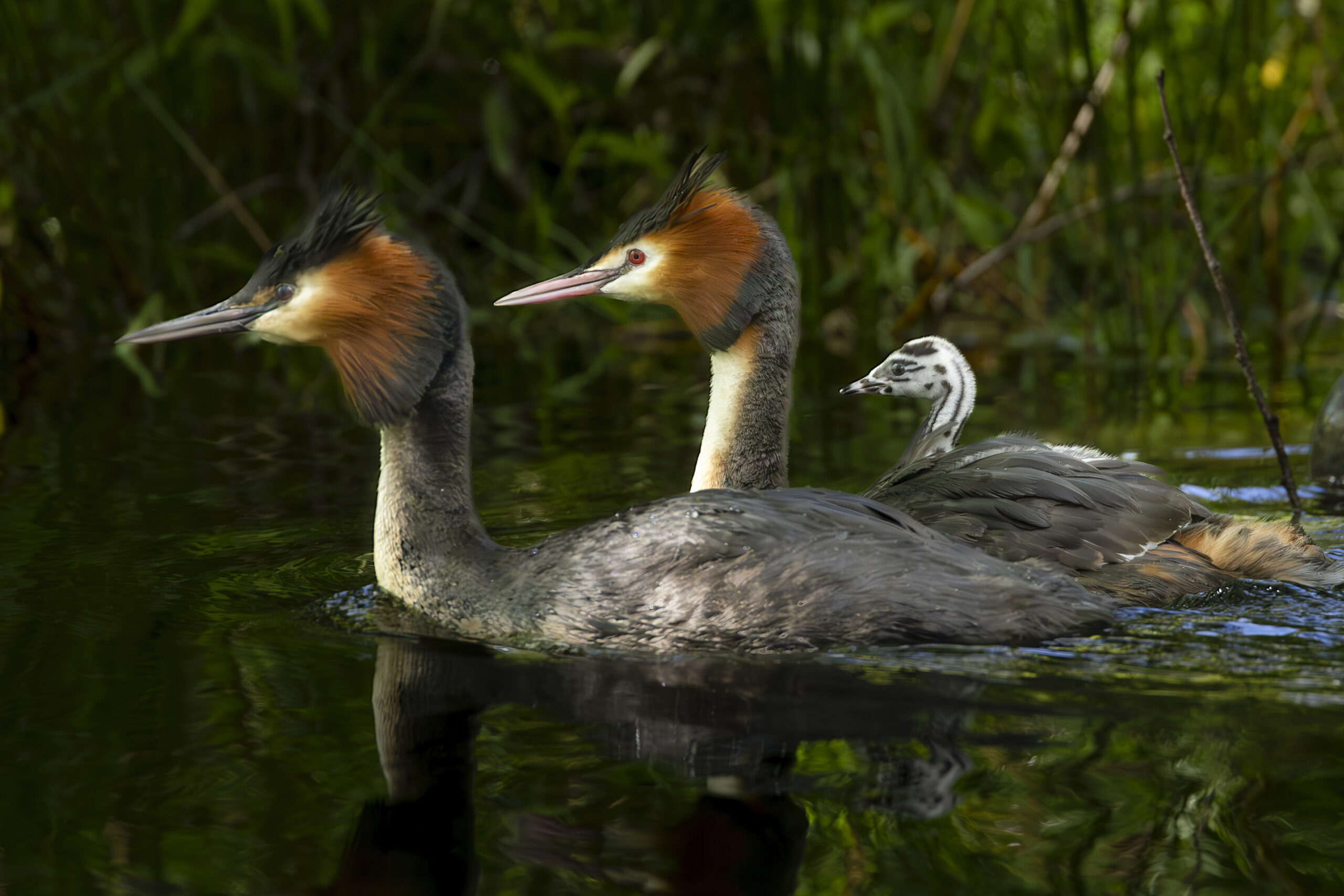
Baffled organisers were soon in a flap as tens of thousands of votes poured in from countries across the globe, briefly crashing counting systems.
With a striking plumage of black, white and brown, New Zealand’s online bird encyclopaedia celebrates the water-loving puteketeke as a “majestic and distinctive” species.
Oliver, meanwhile, less charitably dubbed it the “weird puking bird”.
Puteketeke are known for eating their own feathers in an effort to trigger their gag reflex and throw up parasites, said competition organiser Nicola Toki from conservation group Forest and Bird.
“Puteketeke began as an outside contender, but was catapulted to the top spot thanks to its unique looks, adorable parenting style – and propensity for puking,” Toki said.
They are also known for a strange and elaborate mating ritual which they perform with gusto but apparently limited success – it is believed New Zealand’s puteketeke population has dwindled below 1,000.
It involves enticing a potential mate with weeds dangling from their beaks, before chest bumping them and engaging in a chorus of chirps that experts have called the “growling cat display”.
“I have never identified with anything more,” Oliver said.
Blue horizons
Dive into clear streams, play with river shrimps, and bask in nature’s tranquil hues
The unique thing about being Bruneian is how nature and development live and coincide with one another.
In one vicinity, a vast housing scheme houses thousands, while merely a kilometre away lies Lugu Lake, a beloved body of water, with azure hues reminiscent of the sky.
Remarkably, the lake is not a natural occurrence but a man-made marvel resulting from land excavations during the construction of the RPN Kampong Lugu.
Yet, our exploration extends beyond the lake to the adjacent jungles, to a hiking trail dubbed the Lugu Loop. Located to the side of the lake, the entrance is marked by a modest shack, with a wooden table and a couple of benches.

Though in need of a touch-up, the trail is stunning as it overlooks the crystal waters of Lugu Lake, combined with the sky, its a vast expanse of blue that will clear any mind.
Fittingly named, the trail forms a 3.1-kilometre loop, catering to beginners with its accessible terrain. However, it’s worth noting that, given the current active weather conditions, the trail is muddy, and certain sections may be obstructed by fallen trees.
During our hike, we encountered a fallen branch which was easily moved aside, and observed portions of the path eroded due to the ongoing torrential rains.
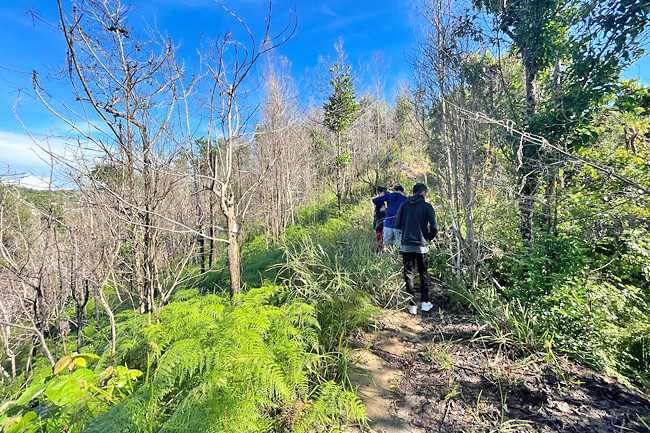
Yet, despite the tall grass and swarm of mosquitoes – too many for 8am – we trekked on getting lost in the myriad of sounds.
Situated amid settlements and modern developments, as is the case with the Lugu Loop, many Bruneian hiking trails offer a blend of urban and natural soundscapes.
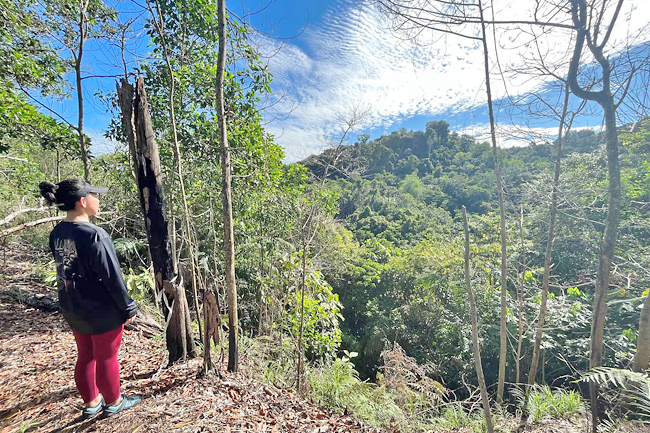
The hum of cars and traffic becomes a symphony on one side, yet a few steps inward, you’re engulfed in the rhythmic beats of the jungle.
The contrast is striking, however over a kilometre in, the ambient noise of human activity is swallowed up by the harmonious chaos of the jungle.
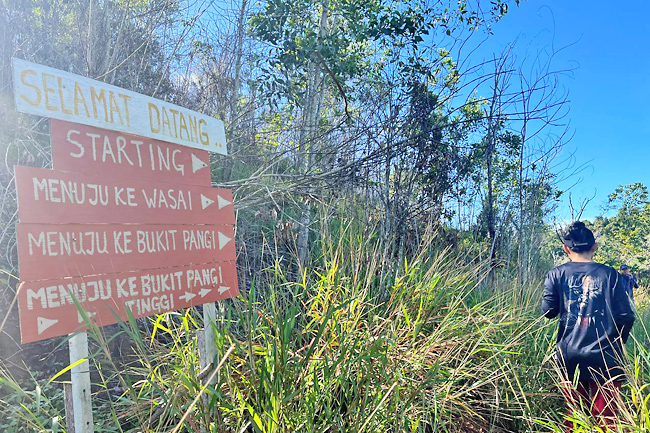
From the rhythmic hum of cicadas to the haunting calls of birds, the paths eventually open up to reveal a wall of luxuriant green jungles.
The journey, though marked by mud and humidity, surprises with its cleanliness, except for the encroaching vegetation. Most importantly, the walk remained serene.
As you progress, the vast blue skies accompanying the start of your hike, gradually yield to the embrace of thick canopies, offering a cooler ambiance.
Further along the trails, you’ll encounter informative handmade signposts.
Some point to paths extending beyond the loop, such as Bukit Pangi, while others playfully implore trekkers not to linger and refrain from littering, expressed with a touch of cheekiness in the Kedayan dialect.
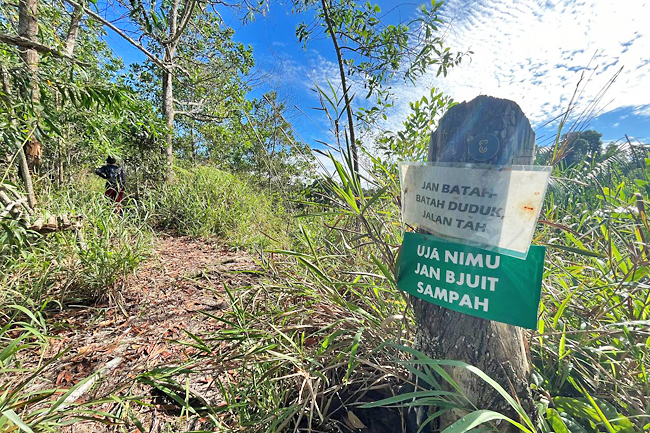
The best part of this trail is its hidden gem – the cascades, or locally referred to as wasai, nestled around the mid-way point.
As the trail unfolds, a secluded expanse reveals itself, featuring a small shack, that a friend shared, is known to be utilised by campers and foragers.
Initially, the wasai appears unassuming, with three or four petite waterfalls culminating in a gentle stream. Despite the frequent rain and mud, one might expect sediment runoff to cloud this natural wonder, but not in this case.

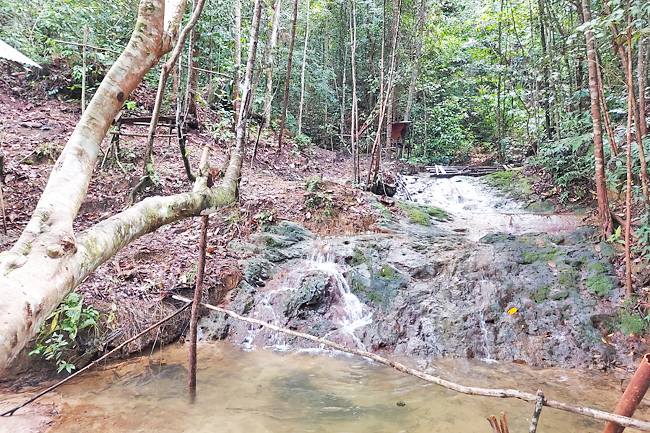
From a distance, the water seems muddy yet upon taking a dip, its clarity surprises.
The group that invited me only instructed to bring extra clothes and towels for what I presumed was a swim in Lugu Lake, so I was unaware of the wasai. Imagine my delight at stumbling upon this hidden jewel during our hike. We spent about an hour at the wasai, relishing its refreshing streams.
Some of the group engaged in a friendly competition, attempting to catch the largest river shrimp before releasing them back into the water.
Resuming the loop, the return journey follows the subsequent stream. Despite a somewhat precarious-looking tree-turned-bridge crossing, the trail back is otherwise straightforward.
The echoes of laughter from kids and families enjoying Lugu Lake signalled our return to the entrance.
It’s still a mystery as to how such natural wonders can be unearthed in seemingly unlikely places. Nevertheless, I find comfort in the endless beautiful discoveries that Brunei never fails to offer. – Wardi Wasil
Fighting stigma
A group of medical students strive to raise awareness and dispel misconceptions on autism spectrum disorder

Autism spectrum disorder (ASD) is a neurodevelopmental condition characterised by a range of challenges related to social interaction, communication, and repetitive behaviours, encompassing a spectrum of symptoms and severity, making each individual’s experience unique.
The topic of inclusivity holds profound significance for individuals with ASD, where they and their allies fight for a society where their unique strengths and perspectives are recognised and celebrated.
Infinity and Beyond was a community outreach project ran by a group of third year medical students from Pengiran Anak Puteri Rashidah Sa’adatul Bolkiah Institute of Health Sciences (PAPRSB IHS) at Universiti Brunei Darussalam that aims to raise awareness on ASD and promote inclusivity.

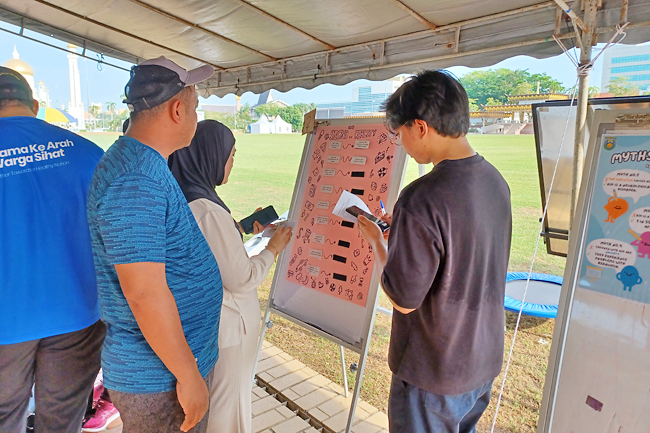
PHOTOS: COHORT
The team collaborated with Society for the Management of Autism Related issues in Training, Education, and Resources (SMARTER) Brunei to better equip themselves in dispelling misconceptions surrounding ASD.
At SMARTER EDGE Centre, the team actively participated in classroom activities, contributing to the teaching of fundamental life skills and were taught the Picture Exchange Communication System (PECS), which is used to facilitate functional communication for children with autism.
“Our team’s dedication extends to experiential learning, navigating obstacles that simulate the challenges faced by ASD individuals daily,” said Infinity and Beyond member Awangku Mohammad Hafiz Ayman bin Pengiran Dr Haji Mohammad Khalifah.
“We faced the challenge of maintaining focus on a balancing board while responding to a barrage of questions, leaping on a trampoline in tandem with a partner while reciting the alphabet, and engaging in various other demanding activities.
“ASD individuals suffer constant balancing issues, which is why we often see them running around in circles to help combat this,” he added.
The team also does volunteer work at the Brunei Autism Centre for Adults (BACA).

After their training at SMARTER, Infinity and Beyond group members organised seminars and talks for parents as well as incorporate awareness initiatives into Bandarku Ceria weekends as well as a health carnival.

Their efforts were recognised by Minister of Culture, Youth and Sports Dato Seri Setia Awang Haji Nazmi bin Haji Mohamad, who commended their efforts and its positive impacts during a visit to their booth at the TEGAS Walkathon.
As the project comes to an end, the team hopes that their efforts during their community outreach persists, believing that the skills and knowledge acquired during the endeavour will serve them well in an unending journey to promote inclusivity. – Rizal Faisal
Man Utd CEO Arnold to leave club

LONDON (AFP) – Manchester United chief executive Richard Arnold is set to leave the Premier League club, with British billionaire Jim Ratcliffe on the brink of buying a 25 per cent stake, reports said on Wednesday.
Arnold, 52, replaced Ed Woodward as United’s top executive in February last year.
Ratcliffe’s INEOS Group is expected to pay about GBP1.25 billion for a minority stake in the Old Trafford club, while also acquiring significant control over footballing operations.
The BBC said the deal was expected to be ratified during the current international break, possibly as early as this week.
Arnold oversaw the appointment of current manager Erik ten Hag in 2022, who last season ended the club’s six-year trophy drought.
But United have had disappointing start to the 2023/24 campaign, losing nine of their first 18 games in all competitions.
The Glazer family announced in November 2022 that they were considering “strategic alternatives” to help the club grow, which included consideration of a sale.
Qatari banker Sheikh Jassim bin Hamad Al Thani and Ratcliffe made offers in the region of GBP5 billion for a complete takeover, but that fell short of the Glazer family’s valuation.
Sheikh Jassim withdrew from the process last month, while Ratcliffe continued to pursue a minority shareholding.
Ratcliffe, 71, who tried to buy Chelsea last year, grew up in the Manchester region and describes himself as a lifelong fan of United.
The deal is likely to lead to a major shake-up of United’s football operations. Dave Brailsford, the former performance director of British Cycling, is expected to have significant influence in his role as INEOS’ director of sport.

Mazzarri makes shock Napoli return
TURIN (AFP) – Walter Mazzarri made a shock return as Napoli manager after Rudi Garcia fell victim to a dismal start to the Italian champions’ Serie A title defence.
Garcia lasted just five months at Napoli after replacing Italy coach Luciano Spalletti, failing to inspire a team which had kept almost all the stars of last season’s first Scudetto since 1990.
Napoli are 10 points behind league leaders Inter Milan in fourth and have been in turmoil for weeks as May’s historic title triumph began to increasingly look like a one-off. Garcia, 59, was fired after Sunday’s 1-0 home loss to Empoli was greeted by a deluge of boos and whistles from supporters, whose joy at being reigning Italian champions has vanished.
Reports of his dismissal emerged almost immediately after that defeat, Napoli’s fourth at home in all competitions.
The announcement of Mazzarri’s Napoli return after a decade away, reportedly on a deal until the end of the current campaign, initially came via owner Aurelio De Laurentiis.
The movie mogul simply wrote “welcome back Walter!” on X, formerly known as Twitter, after the club confirmed Garcia’s sacking.

Marcos aims high: APEC’s food, energy boost


MANILA (ANN/PHILIPPINE DAILY INQUIRER) – Setting the stage for a strategic mission, Philippines President Marcos outlined his priorities in a compelling pre-departure address at Villamor Airbase in Pasay City.
Emphasising a multifaceted approach, he expressed his commitment to fostering beneficial trade, encouraging investment, promoting green job creation, advancing human development, and alleviating poverty.
In the upcoming APEC summit, Marcos plans to engage with diverse business leaders through impactful roundtable discussions, aiming to forge collaborative solutions for shared prosperity.
He will also meet with private sector representatives from the APEC Business Advisory Council
The President also said he will serve as a keynote speaker at the APEC Chief Executive Officers (CEO) Summit.
“At the APEC CEO Summit, which is the annual gathering of top CEOs from across the APEC region, I have been invited to deliver keynote remarks on ‘intentional equity in sustainability’ to share the Philippine experience in ensuring inclusivity on our path to greening the economy,” said Marcos.
In attendance at the departure ceremony were his cabinet secretaries, as well as Vice President Sara Duterte.
Marcos is scheduled to fly back to Manila on November 20.
China’s economy sparks amid struggles
BEIJING (AP) – China’s economy showed more signs of reviving in October as retail sales and manufacturing picked up though the property sector remained sluggish, the government said Wednesday.
Factory output rose 4.6 per cent from a year earlier in October, while retail sales jumped 7.6 per cent, helped by robust spending during the weeklong National Day holidays.
But real estate investment sank 9.3 per cent, and officials acknowledged that the industry was still in the “midst of adjustment,” after a crackdown on excessive borrowing by developers two years ago, coupled with the pandemic, and plunged the industry into crisis.
Disruptions to manufacturing, transport, travel and virtually every other aspect of life during the pandemic ended nearly a year ago when China’s leaders abandoned their “zero-COVID” policies aimed at preventing infections.
So improved economic data from October also reflect lower rates of growth a year earlier. Overall, China’s recovery from the pandemic has been fitful, though recently activity has revived, leading many economists to upgrade their estimates for growth this year to above the government’s target of about 5 per cent.
China’s economy slowed in the summer as global demand for its exports faltered and the property sector deteriorated further. The economy expanded at a 4.9 per cent annual pace in July-September, beating analysts’ forecasts of about 4.5 per cent, official data show. But that was much slower than the 6.3 per cent annual growth rate of the previous quarter.
The recent evidence that the world’s No 2 economy is again gaining steam comes just as President Xi Jinping is due to meet later Wednesday with US President Joe Biden on the side-lines of a Pacific Rim summit in California.
Briefing reporters in Beijing, Liu Aihua, a spokesman for the National Bureau of Statistics, repeatedly emphasised China’s transition to new models of growth, part of a decades-long shift from rapid industrialisation and heavy investments in factories, ports and other infrastructure to a more sustainable pace of growth led by consumer spending.
The economy was continuing to improve under “effective” policies, though its recovery was experiencing “wave-like development and tortuous progress,” he said. “At present, the external pressure is still great, the constraints of insufficient domestic demand are still prominent, enterprises have many difficulties in production and operation, and hidden risks in some fields require much attention,” Liu said.
The report showed consumer spending is playing an increasingly important role in driving growth, with consumption contributing 83.2 per cent to economic growth in January-October, up six per cent from the same period a year earlier. Given the wide gap between the incomes of city dwellers and people living in rural areas, there is ample room for growth, Liu said.
The auto industry stands out. Sales of passenger cars rose 10.2 per cent in October over a year earlier as makers ramped up promotions and customers opted for electric and hybrid vehicles. Exports of passenger cars jumped nearly 50 per cent to 391,000 units in October and have risen 66 per cent this year, to just over three million units, the China Passenger Car Association reported last week.
But he acknowledged that Chinese families have limited leeway to spend and that employment remains an issue.
Overall unemployment remained at five per cent in October. The government stopped announcing the rate of unemployment for young workers months ago, once it topped 20 per cent.
Liu said the statistics bureau and other relevant departments were researching the issue and working to improve collection of statistics and that updates on the situation would be released “at an appropriate time.”

Flight eco-tax takes off in Denmark

THE WASHINGTON POST – Denmark has announced a new proposal to implement a “green tax” on all flights in an effort to fund a sustainable-energy transition for its domestic air travel.
Released Thursday, the plan by the Scandinavian country would charge passengers (in Danish krones) around USD9 for flights within Europe, USD35 for medium-distance flights and USD56 for long-distance flights by 2030. The policy would be phased into effect beginning in 2025.
Half of the revenue from the “green tax” – which is expected to bring in around DKK1.2 billion – would be used to support a transition to have all domestic flights use 100 per cent sustainable fuels by 2030.
(The country plans to have its first all-green-fuelled domestic flight route in operation in 2025.)
Another portion of the revenue would support pension increases for elderly citizens.
“Flying takes a toll on the climate, which is why we need to equip our flight sector with green wings,” Denmark’s Minister for Climate, Energy and Utilities Lars Aagaard said in a statement.
“The flight sector in Denmark must – as all other sectors – lower its carbon foot print and get on board a green future. We will create that change and make green flights our reality.”
Globally, the aviation industry accounted for two per cent of all energy-related CO2 emissions in 2022, according to the International Energy Agency. Pre-pandemic, this number was even higher.
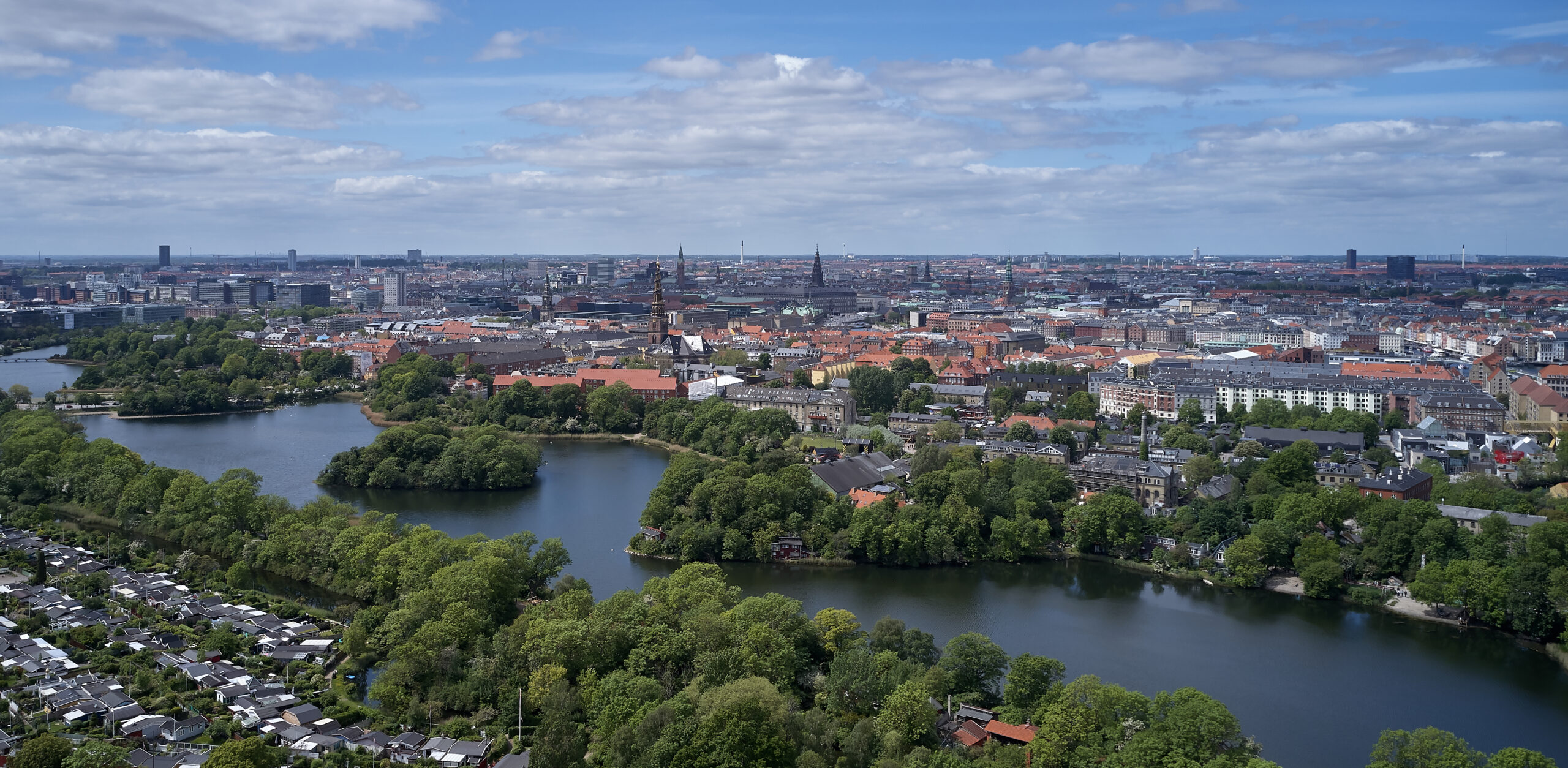
A 2020 study by the National Oceanic and Atmospheric Administration on the aviation industry found that “global air travel and transport is responsible for 3.5 per cent of all drivers of climate change from human activities.”
Some estimates see aviation’s share in global carbon emissions rising to 22 per cent by 2050.
The move by the Danish government follows similar policies elsewhere in Europe that aim to limit the negative climate effects of air travel. At the start of this year, the government of the Netherlands tripled its passenger tax on air travel in another bid to curb carbon emissions.
And earlier this summer, France became the first country in the world to enact a legal ban on any domestic short-haul flights between places where an easy train alternative exists, and where the train trip is less than 2.5 hours.
Though a legal first, climate advocates found the law lacking, as routes banned by the law accounted for less than three per cent of domestic flight emissions. The original proposal that came from the French climate “citizens’ assembly” applied to flights where the train travel was under four hours, but the plan was watered down in the legislature.
Though short-haul flights especially are extremely energy-intensive and make up about 25 per cent of US air traffic, similar proposals have not yet made way in the US, where the aviation industry accounts for about three per cent of total greenhouse gas emissions.
Initiatives to stop or lessen air travel are generally more popular in Europe than in the US, where lack of government initiative and alternative high-speed travel infrastructure such as trains has limited action.
Though the Inflation Reduction Act passed by Congress in 2022 included tax credits and research funding to support the US production of “sustainable aviation fuels” (SAFs), for example, it doesn’t cut down or attempt to manage flight frequency.
Recent years have also seen a growing international movement of scientists, professionals and consumers advocating for less air travel, some going as far as to stop traveling by plane altogether.
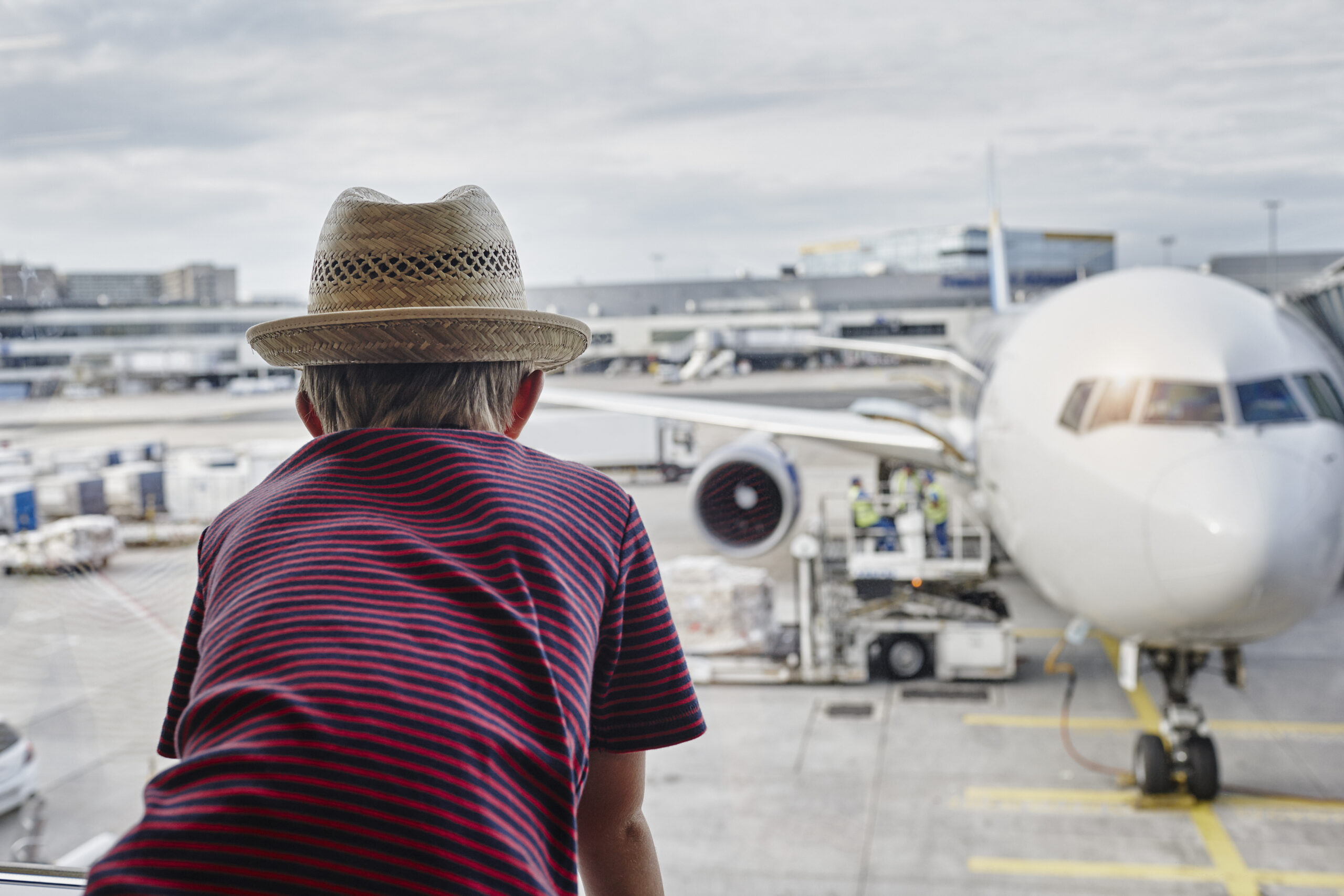
We Stay on the Ground, a Sweden-based group, had 26,000 people sign up for its “flight free” campaign in 2020, for example. And in the United States, NASA data scientist Peter Kalmus started No Fly Climate Sci, a loosely organised group of “scientists, academics, and members of the public who either don’t fly or who fly less” in order to cut down their carbon footprint and limit their contribution to climate change.
The website began in 2017 and has since grown to include a few dozen entries from across the globe.
Despite some vocal supporters and high-visibility public efforts – like Greta Thunberg’s trip across the Atlantic via high-speed sailboat – the movement for less flight travel hasn’t reached the mainstream.
Still, governments, especially in Europe, have taken clear steps to regulate the climate impacts of the aviation industry, both through policies like Denmark’s proposed tax and by cracking down on “greenwashing” airlines misrepresenting their sustainability practices, as was the case in an EU-wide complaint filed by consumer groups this fall.
“This proposal is little more than greenwash that will ultimately fuel the industry’s growth. The tax is too tiny for demand reduction, and most of it will be swallowed by the industry,” Magdalena Heuwieser, co-founder of the Stay Grounded network, said in an email.
Heuwieser said Denmark has enough rail connections to ban all domestic flights. “This would be much more sustainable, as flying is always more energy intensive, no matter which technology might come up in the future.” – Sofia Andrade




